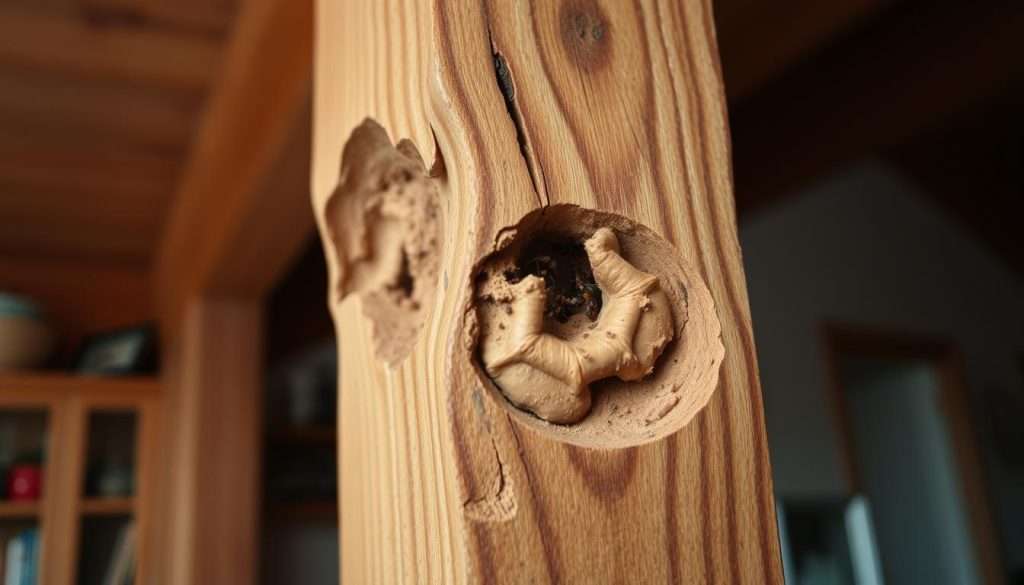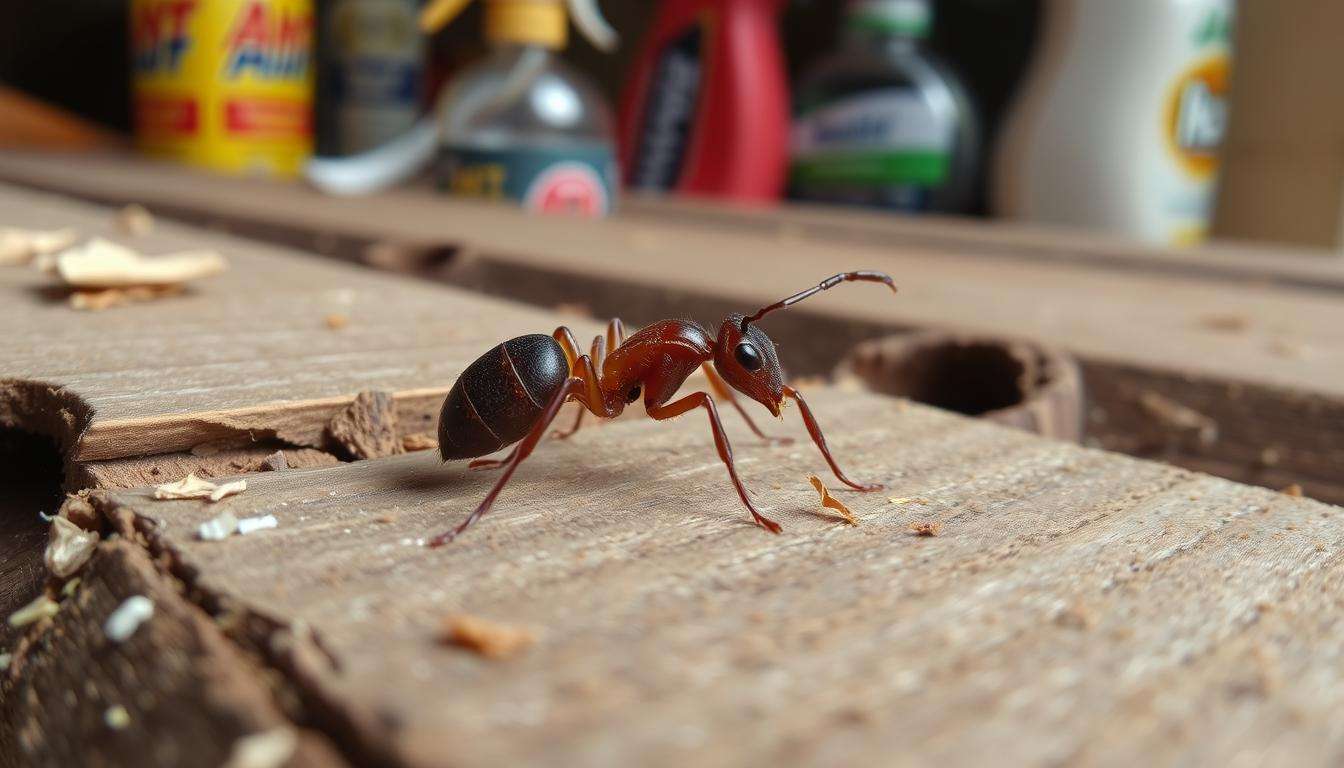Large black ants in your home or wood damage? You might have carpenter ants. Knowing how to get rid of them is key. They can harm your home by digging through wood. Our guide will show you how to control carpenter ants and keep your home safe.
Carpenter ants can grow up to 3/4 inch long. They are usually black but can be reddish-brown or yellowish. Spotting their nests and signs of infestation is important. Look for wood shavings and ant wings.
In this guide, we’ll teach you how to treat carpenter ants. We’ll cover finding nests and using bait methods. This will keep your home safe from these pests. Let’s tackle this problem together!
Key Takeaways
- Carpenter ants can cause structural damage to homes.
- Identifying signs of infestation is crucial for effective control.
- Moisture and food sources attract carpenter ants into your home.
- Locating the nest is key to eliminating carpenter ants effectively.
- Preventive measures can help keep carpenter ants at bay.
Understanding Carpenter Ants
Carpenter ants can be a problem for homeowners because they dig into wood. It’s important to know what these pests are and which carpenter ant species you might see. This knowledge helps you manage and prevent infestations.
What are Carpenter Ants?
Carpenter ants belong to the genus Camponotus. They don’t eat wood like termites do. Instead, they dig into wood to make nests. They like damp, rotting wood, so fixing moisture issues is key.
These ants are 3/8 to 3/4 inch long and come in black, reddish-brown, and yellowish colors. The black carpenter ant is the most common in the U.S.
The life cycle of carpenter ants includes several stages. A queen lays 15-20 eggs, which hatch into larvae. These larvae grow into worker ants.
Worker ants gather food and dig nests. A colony can have 10,000 to 50,000 workers. Unlike termites, carpenter ants don’t eat wood. They just remove it from their nests.
Common Species of Carpenter Ants
Knowing the common carpenter ant species helps you spot them. Here’s a table with some species, their looks, and where they like to be:
| Carpenter Ant Species | Color | Size (Length) | Habitat |
|---|---|---|---|
| Black Carpenter Ant | Black | 3/8 to 3/4 inch | Damp wood, both indoors and outdoors |
| Reddish Carpenter Ant | Reddish-brown | 1/4 to 1/2 inch | Old trees, stumps, and decaying structures |
| Yellow Carpenter Ant | Yellowish | 1/4 to 1/2 inch | Moist areas in gardens, wooden structures |
To wrap it up, knowing about carpenter ants and their types helps homeowners spot problems early. Being proactive is key to preventing and controlling infestations.
How to Identify Carpenter Ants in Your Home
Spotting carpenter ants means looking at their looks and any signs of trouble. Knowing these details helps figure out if your home is in danger.
Physical Characteristics of Carpenter Ants
To spot carpenter ants, look for their special traits. They are 0.5 to 1 inch long, depending on their role. Here are the key features:
- Body Shape: Carpenter ants have a slim waist and a smooth, rounded thorax.
- Antennae: Their antennae are bent, which helps in distinguishing them from other ant species.
- Color: They can vary in color but are generally black or reddish.
- Wings: Winged carpenter ants, which are often seen during swarming season, can be indicative of a mature colony.
Signs of an Infestation
Signs of carpenter ant trouble are important to spot early. Look for these signs that mean you might have a problem:
- Discarded wings around windows or doors suggest swarming behavior, often occurring in late winter or early spring.
- Piles of wood shavings, known as frass, near baseboards or wooden structures signal tunneling activity.
- Small holes in wooden surfaces show where they have started to carve out their nesting galleries.
- Rustling noises inside walls may be heard, and tapping on wood may produce a hollow sound, indicating hidden nests.
Knowing how to spot carpenter ants is key to protecting your home. Watch for the signs and traits mentioned to catch infestations early.
Top Reasons Why You Might Have Carpenter Ants
Knowing why carpenter ants invade homes is key to stopping them. Many things can bring these pests inside. It’s important to know what they like and how they behave.
Foraging for Food
Carpenter ants look for food to get into your home. Worker ants search far and wide for it. They like:
- Insects
- Proteins
- sugary substances
When food is hard to find outside, they might look for it inside your home.
Moisture Damage
Moisture and carpenter ants go hand in hand. They love damp wood, which means there might be moisture problems. Look for signs in:
- Leaky roofs
- Damaged gutters
- Insufficient drainage
Fixing these issues quickly can help keep carpenter ants away. They prefer wet places.
Proximity to Nearby Nests
Being close to carpenter ant nests increases the chance they’ll come into your home. Look for signs near your home, like:
- Old tree stumps
- Piles of firewood
- Organic debris in yards
Watching these spots can help you understand how close you are to carpenter ants.
How to Get Rid of Carpenter Ants in House
To remove carpenter ants, you need a plan. Look for their nests, use baits, and apply insecticides. This will help you get rid of them naturally and keep your home safe.
Locating the Carpenter Ant Nest
Finding the nest is key. Check moist areas since ants like these spots. Watch for trails at night. Listen for sounds in walls. Remember, nests can be just 300 feet away.
Using Baits for Elimination
Baits are a good way to fight ants. Use toxic baits that ants carry back to their home. Mix sugar and protein baits for better results. This is a natural way to get rid of ants.
Applying Insecticides Effectively
Choosing the right insecticides is important. Use non-repellent types like Termidor SC and Phantom. Follow the instructions to apply them right. This will help you get rid of ants for good.

| Method | Description | Key Products |
|---|---|---|
| Locate Nest | Search near moisture sources and listen for nesting sounds. | N/A |
| Using Baits | Employ sugar and protein-based toxic baits for worker ants. | Raid Ant Baits, Amdro Ant Block |
| Insecticide Application | Use non-repellent insecticides targeting the nest. | Termidor SC, Phantom |
Preventing Carpenter Ant Infestations
Prevention is key to fight carpenter ant infestations. Taking steps early helps keep your home safe. Here are some ways to prevent carpenter ants:
Moisture Control Tips
Moisture draws carpenter ants. It’s vital to control moisture.
- Fix any leaks in plumbing or roofing right away.
- Make sure crawl spaces and basements have good air flow.
- Keep indoor humidity between 30% and 50%.
- Remove standing water from gutters and downspouts.
- Look for damp spots that could cause wood rot.
Sealing Entry Points
Check your home’s outside well to seal ant entry points.
- Check doors and windows for gaps and seal them with caulk.
- Use mesh or screen to cover vents and openings.
- Fill cracks in the foundation and around pipes.
- Install thresholds and door sweeps to secure doors.
Maintaining Your Landscape
Good landscaping helps prevent carpenter ants. A well-kept yard lowers the risk of infestation.
- Trim trees and bushes so they don’t touch the roof or siding.
- Store firewood off the ground and away from your house.
- Remove extra mulch or wood chips near your foundation.
- Check for rotting wood and get rid of it.
Why Carpenter Ant Control is Important
Keeping carpenter ants away is more than just a nuisance. It’s crucial for protecting your home and health.
Potential Damage to Your Home
Carpenter ants can damage your home over time. They make tunnels in wood, but they don’t eat it. This damage caused by carpenter ants might not show up right away. But, it can cost a lot to fix if you don’t stop it.
They like to nest in wet wood, like around chimneys or under bathtubs. A big colony can have thousands of ants. This means a lot of damage to your home.
Health Risks Associated with Infestations
Carpenter ants don’t carry diseases. But, they can show that there’s too much moisture. This can lead to mold, which is bad for your health.
It’s important to keep your home dry to avoid health problems. Mold and damp places can make you sick.

Conclusion
Managing carpenter ants in your home is key to keeping it safe and healthy. Knowing their habits and signs of infestation helps you act fast. You can use professional help or home remedies like sugar and baking soda to stop damage.
This guide showed how to fight carpenter ants by targeting the queen and destroying their nests. It’s important to know what attracts them, like moisture and rotting wood. Use bait traps and keep your yard clean to keep them away.
Being proactive in fighting carpenter ants protects your home. For more tips on dealing with infestations, check out this helpful resource. Let’s all work together to keep our homes pest-free!
